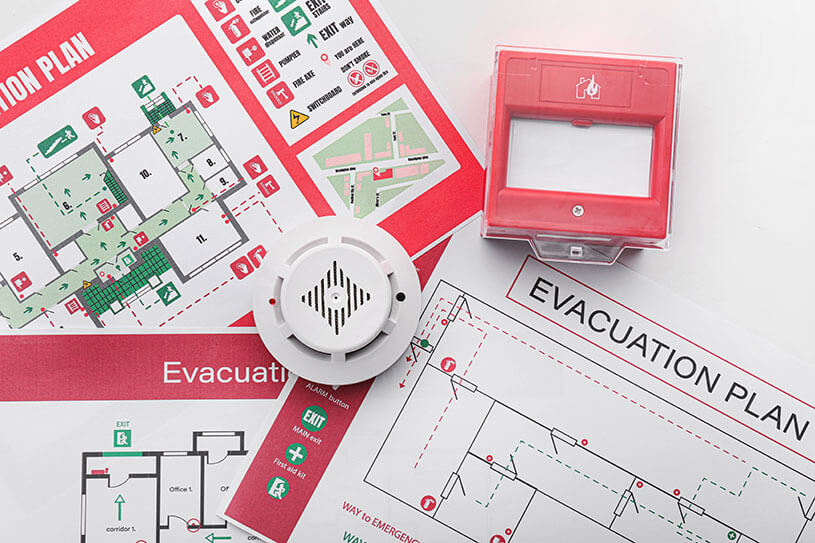All businesses should have a fire safety policy to reduce the risks and ultimately keep you, your employees, and any contractors safe on site. Here’s what should go into creating your own fire safety policy.
Whether you’re a sole trader or a business with employees, this policy will need to grow with you.
- What is a fire safety policy?
- Who is responsible for your company’s fire safety policy?
- What should be included in a fire safety policy?
- Creating a fire safety risk assessment
- How to appoint a fire marshal
- What should an evacuation plan look like?
- Fitting fire safety signs
- Fire safety training
- How to use a fire safety policy
What is a fire safety policy?
You should also make sure that any staff and contractors are aware of the policy and explain that everyone is expected to comply with it.
Who’s responsible for the fire safety policy?
You’re legally required to have a ‘responsible person’ within your business, who’ll be liable for compliance under the legislation. They should be someone employed by the business, and not an external consultant or supplier. If you’re a sole trader, then this responsibility will fall to you.
Areas of responsibility include:
- developing and maintaining a fire safety plan
- making sure your premises is a safe place to work for staff and visitors
- regularly carrying out staff training on fire safety
- completing a fire safety risk assessment and keeping it up to date
- making sure staff know the emergency evacuation plan
What should be included in a fire safety policy?
A basic fire safety policy template can include:
- what’s covered and who it applies to
- consequences of non-compliance
- name and duties of the ‘responsible person’
- potential fire hazards and how to report them
- responsibilities of the fire marshal
- responsibilities and duties of employees
Your fire safety policy should also include how to reduce risks and report any hazards, as well as documenting a clear evacuation plan.
Creating a fire safety risk assessment
The responsible person must carry out a fire safety risk assessment and review it regularly. This will identify what needs to be done to prevent fires in your place of business and include measures to keep people safe if there is one.
To carry out a risk assessment, you’ll need to:
- Identify any fire hazards on your premises
- Identify the people who might be at risk
- Remove or reduce the potential hazards
- Create a written record of your findings
- Prepare an emergency plan and provide fire safety training
What should an evacuation plan look like?
An evacuation plan should show:
- a clear passageway to all escape routes
- clearly marked escape routes
- emergency lighting
- training for all employees
- a safe meeting point for staff
You might also want to mention things like whether you have a paperless office or a clear desk policy.
Your policy should also outline how you’ll manage instances of people not complying.
The government website has more information on building a fire safety plan, including an idea of what you’ll want to include.
Any fire safety plan must prioritise evacuating people safely over protecting or rescuing equipment or other items.
Fitting fire safety signs
Since you’re legally required to make sure employees and anyone else working for you knows about your fire safety policy, you might want to display the information on fire safety signs.
You can use them to show what employees should do in case of a fire – including escape plans and how to raise the alarm – and note who the fire marshal and any other responsible person might be.
Appointing a fire marshal
You might choose to appoint a fire marshal to carry out certain responsibilities, such as:
- checking exits are clear and usable each working day
- making sure fire fighting equipment is in the right place
- completing the fire risk assessment
- checking and testing the fire alarm
Fire safety training
There are specific fire marshall training courses available covering everything your fire marshall will need to know to fulfil their role. These will also help other people who are responsible for overseeing fire safety, or anyone who might need to know how to use a fire extinguisher. St John’s Ambulance, for example, offers a fire marshall safety course including information on fire detection and warning, fire precautions and regulations, arson and the cost of fire damage.
It’s important to note that overall responsibility for fire safety is always with the employer and not your fire marshal.
How to use a fire safety policy
Make sure your fire safety policy is as specific to your business as possible. For example, make sure any listed fire marshal duties match your business needs and activities. And when listing potential fire hazards, you might wish to highlight specific hazards to your business environment.
It’s also important that this policy grows as your business does. For example, if you’re a sole director with no employees and therefore no managers, this policy will need to be updated when your business changes in size.
Rather than having to keep updating it, we recommend that you maintain any wording to cover your position and to provide you with the right guidance as you grow.
Do you have any questions about creating a fire safety policy UK template? Let us know in the comments.
More small business guides and policies
- Health and safety policy for small businesses
- How to write a staff handbook
- How to support mental health at work as an employer
- How much business insurance do I need?
Looking for employers’ liability cover?
As the UK’s biggest business insurance provider, we specialise in employers’ liability insurance. We’ll run you a quick, tailored quote right now online, and let you decide if we’re a good fit.
Photo: Pixel-Shot/stock.adobe.com
